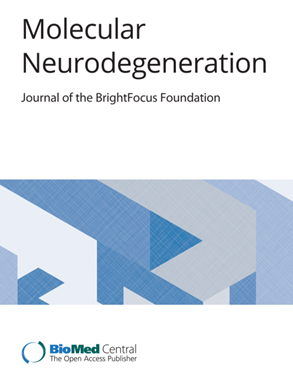在阿尔茨海默病中通过 RNAase-H 活性反义寡核苷酸调节体内人类小胶质细胞基因的表达和功能
IF 14.9
1区 医学
Q1 NEUROSCIENCES
引用次数: 0
摘要
小胶质细胞在维持大脑稳态和神经变性方面发挥着重要作用。载脂蛋白 E(APOE)和髓样细胞上表达的触发受体 2(TREM2)等主要或专门在髓样细胞中表达的基因的遗传变异被发现是阿尔茨海默病(AD)的最强风险因素,这凸显了小胶质细胞生物学在大脑中的重要性。几种小胶质细胞蛋白的序列、结构和功能在不同物种间的一致性很差,这阻碍了旨在调节特定小胶质细胞基因表达的策略的开发。针对 APOE 和 TREM2 的一种方法是使用反义寡核苷酸(ASO)来调节它们的表达。在这项研究中,我们发现、生产并测试了针对人类 APOE 和 TREM2 的新型、选择性和强效 ASO。我们结合使用了体外 iPSC-小胶质细胞模型以及小胶质细胞异种移植小鼠,以证明其在体内人类小胶质细胞中的活性。我们证明了它们在体外人类 iPSC 小胶质细胞中的疗效,以及在异种移植小胶质细胞模型中的体内药理活性。我们证明了以人类小胶质细胞为靶点的 ASOs 可以改变它们的转录谱,以及它们在体内 AD 模型中对淀粉样蛋白-β 斑块的反应。这项研究首次证明了人类小胶质细胞可以通过 ASOs 以剂量依赖的方式进行调节,从而操纵体内小胶质细胞的表型和对神经变性的反应。本文章由计算机程序翻译,如有差异,请以英文原文为准。
Regulation of human microglial gene expression and function via RNAase-H active antisense oligonucleotides in vivo in Alzheimer’s disease
Microglia play important roles in maintaining brain homeostasis and neurodegeneration. The discovery of genetic variants in genes predominately or exclusively expressed in myeloid cells, such as Apolipoprotein E (APOE) and triggering receptor expressed on myeloid cells 2 (TREM2), as the strongest risk factors for Alzheimer’s disease (AD) highlights the importance of microglial biology in the brain. The sequence, structure and function of several microglial proteins are poorly conserved across species, which has hampered the development of strategies aiming to modulate the expression of specific microglial genes. One way to target APOE and TREM2 is to modulate their expression using antisense oligonucleotides (ASOs). In this study, we identified, produced, and tested novel, selective and potent ASOs for human APOE and TREM2. We used a combination of in vitro iPSC-microglia models, as well as microglial xenotransplanted mice to provide proof of activity in human microglial in vivo. We proved their efficacy in human iPSC microglia in vitro, as well as their pharmacological activity in vivo in a xenografted microglia model. We demonstrate ASOs targeting human microglia can modify their transcriptional profile and their response to amyloid-β plaques in vivo in a model of AD. This study is the first proof-of-concept that human microglial can be modulated using ASOs in a dose-dependent manner to manipulate microglia phenotypes and response to neurodegeneration in vivo.
求助全文
通过发布文献求助,成功后即可免费获取论文全文。
去求助
来源期刊

Molecular Neurodegeneration
医学-神经科学
CiteScore
23.00
自引率
4.60%
发文量
78
审稿时长
6-12 weeks
期刊介绍:
Molecular Neurodegeneration, an open-access, peer-reviewed journal, comprehensively covers neurodegeneration research at the molecular and cellular levels.
Neurodegenerative diseases, such as Alzheimer's, Parkinson's, Huntington's, and prion diseases, fall under its purview. These disorders, often linked to advanced aging and characterized by varying degrees of dementia, pose a significant public health concern with the growing aging population. Recent strides in understanding the molecular and cellular mechanisms of these neurodegenerative disorders offer valuable insights into their pathogenesis.
 求助内容:
求助内容: 应助结果提醒方式:
应助结果提醒方式:


